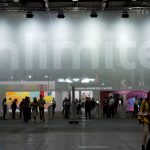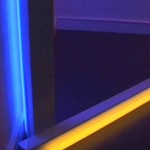The Kunstmuseum Basel presents an extensive exhibition titled “Dan Flavin: Dedications in Lights,” dedicated to the pioneering American Minimal Art artist Dan Flavin (1933–1996). With fifty-eight works, including pieces never before seen in Switzerland, the exhibition offers a thematic and chronological exploration of Flavin’s unique oeuvre. Focusing on works dedicated to individuals or events, it marks the artist’s first major show in Switzerland in twelve years. Flavin revolutionized art by using industrially manufactured fluorescent tubes to create three-dimensional light installations, challenging traditional notions of authorship and art production. Despite his insistence on the factual nature of his art, Flavin often dedicated his works to friends, artists, and political events, adding an emotional dimension to his impersonal creations. The exhibition also showcases Flavin’s drawings and contextualizes his work within its social and historical milieu. Additionally, it highlights the significance of Basel in Flavin’s career, including his permanent installation at the Kunstmuseum Basel’s courtyard, which initially faced opposition but now stands as a testament to the transformative power of art. The retrospective at Kunstmuseum Basel runs until August 18, 2004.
Dan Flavin: Dedications in Lights / Kunstmuseum Basel | Neubau. Curators: Josef Helfenstein, Olga Osadtschy, Elena Degen. Exhibition tour and introduction by Olga Osadtschy. Basel (Switzerland), April 4, 2024.
— Right-click (Mac: ctrl-click) this link to download Quicktime video file.
Press text (excerpt):
Under the title Dan Flavin. Dedications in Lights, the Kunstmuseum Basel dedicates an extensive special exhibition at its Neubau venue to a pioneer of Minimal Art: the American artist Dan Flavin (1933–1996) rose to fame in the early 1960s with his work with industrially manufactured fluorescent tubes. Showcasing fifty-eight works, some of which have never been on view in Switzerland, the exhibition presents a thematically as well as chronologically organized survey of Flavin’s singular oeuvre, with a focus on works he dedicated to individuals or events. It is the artist’s first major show in Switzerland in twelve years.
Dan Flavin made history by creating a new art form. His works made of light extricated color from the context of painting and transposed it into three-dimensional space. Using commercially available light fixtures, he defied conventional ideas about authorship and processes of art production: His decision to make art out of a mundane utilitarian object, radical even by today’s standards, caused a stir among his contemporaries. The earliest exhibitions of Flavin’s fluorescent lamps in New York left artists and critics thrilled by his purism, the fascination of his “gaseous images” (a term the artist himself liked to use), and the physical immediacy of their glowing presence.
Flavin’s fluorescent tubes bring to mind factory halls, fast-food restaurants, and parking lots. The artist leveraged this effect and the limited palette of colors—blue, green, red, pink, yellow, ultraviolet, and four different shades of white—predetermined by the technology. In the course of his career, single tubes and simple geometric arrangements evolved into complex architectonic works and elaborate multipart series. Flavin insistently rejected the designation “sculpture” or “painting” for his works, which he preferred to characterize as “situations.” In his writings and other statements, he moreover emphasized the factual quality of his art. In the catalogue accompanying his first major work for an institution, installed at the Van Abbemuseum in 1966, he wrote:
“Electric light is just another instrument. I have no desire to contrive fantasies mediumistically or sociologically over it or beyond it. (…) I do whatever I can whenever I can with whatever I have wherever I am.”
Flavin’s uncompromising self-limitation to working with a single industrially manufactured object and the serial quality of his creations arguably aligns his oeuvre with Minimal Art. Besides Flavin, Carl Andre, Donald Judd, Sol LeWitt, and Robert Morris are widely regarded as the movement’s leading protagonists—though each of them more or less firmly repudiated the label.
The dedications
Flavin championed an art that does not aim for any profound psychological and spiritual impact and is instead meant to be perceived in passing. The artist himself negated the symbolic tenor of his work and disregarded its sometimes sublime effect. Yet as numerous art critics have pointed out, Flavin’s work can nonetheless be connected to Christian and metaphysical motifs, suggesting allusions to spaces of prayer and meditation illuminated by votive candles. He rebuffed such views with the ironic dictum “It is what it is and it ain’t nothin’ else.”
What is striking, though, is that Flavin habitually dedicated his works throughout his career, associating them, often in sentimental and solemn fashion, with individuals or events. Many of the fluorescent light installations he produced from 1963 on are dedicated to artist friends like Jasper Johns, Sol LeWitt, and Donald Judd. Modernists like Henri Matisse, Vladimir Tatlin, and Otto Freundlich likewise make appearances in Flavin’s titles. These dedications stand in deliberate contrast with the anonymity of the material. By integrating them into his titles, Flavin anchored the non-narrative and impersonal works in a specific aesthetic, political, and social context.
The constitutive role of the titles is also salient when Flavin makes reference to political events. Some works commemorate wartime atrocities and must be read in connection with Flavin’s outspoken opposition to the Vietnam War: see, for instance, monument 4 for those who have been killed in ambush (to P.K. who reminded me about death), which he showed in the exhibition Primary Structures. Younger American and British Sculptors at the Jewish Museum, New York, in 1966, one of the first institutional presentations of the rising minimalist movement’s output.
No less remarkable are the pieces that Flavin dedicated to people he worked with. A prominent example in the exhibition is untitled (to you, Heiner, with admiration and affection), dedicated to the legendary German art dealer Heiner Friedrich. After immigrating to the U.S., Friedrich, in 1974, founded the influential Dia Art Foundation, which supports the permanent and publicly accessible installation of works by a group of artists of the 1960s and 1970s. The work from the Pinakothek der Moderne, Munich, is a so-called “barrier,” a type that Flavin developed in order to close off part of the exhibition space to visitors.
Taking many different forms, the dedications introduce an emotional dimension and highlight the web of artistic and literary references and personal relationships that informed Flavin’s work. One central objective of the exhibition at the Kunstmuseum Basel is to throw this dimension of his art into relief.
In addition to Flavin’s installations, some of which take up entire rooms, the presentation includes drawings: portraits and depictions of nature that have received comparatively little public attention as well as sketches for works and diagrams. The small notebooks he kept were a vital tool for Flavin and constitute a kind of archive of his oeuvre, which spans over three decades. Last but not least, the exhibition brings into focus the social and historical context in which Flavin’s seminal earliest works with light came into being.
A Basel story
Thanks to the committed efforts of Carlo Huber, director of Kunsthalle Basel, and Franz Meyer, director of the Kunstmuseum Basel, a double exhibition of the artist’s work at the two museums opened in 1975. An enthusiastic admirer of the “elementary” quality of Flavin’s handling of light, Huber showcased Five Installations in Fluorescent Light, samples, he wrote, from an “oeuvre of deeply personal character and considerable authority.”
Meyer, for his part, consulted with the artist to compile a selection of ca. 277 works on paper: drawings, etchings, and technical plans as well as several works by the Swiss Renaissance artist Urs Graf, of whom Flavin grew especially fond while working in Basel.
Flavin’s site-specific work untitled (in memory of Urs Graf) has been permanently installed in the Kunstmuseum Basel | Hauptbau’s interior courtyard since 1975. By now we cannot even imagine the courtyard without the extraordinarily atmospheric play of pink, yellow, green, and blue light. In the late 1970s, however, the museum’s trustees still disagreed over whether the work should remain in place. A final decision was only made when the Dia Art Foundation gifted it to the Kunstmuseum, whose leaders even then preferred to keep it switched off. The episode exemplarily illustrates that it took insistent advocacy to bring about what was a radical transformation of habits of seeing and shift of opinion. Documents from the institutions’ archives that shed light on this process are on view in the new exhibition.
Eminent works on loan and important series
The exhibition Dan Flavin. Dedications in Lights brings together thirty-five light installations, twenty-one works on paper, two early paintings by Flavin that are rarely displayed, and a selection from the works by Urs Graf that Flavin chose for his presentation at the Kunstmuseum Basel in 1975. It includes works from eminent public and private collections and institutions such as the Guggenheim Abu Dhabi; the Pinakothek der Moderne, Munich; the Kunstforum Ostdeutsche Galerie, Regensburg; the Museum of Modern Art, New York; and the Panza Collection, Mendrisio. Thanks to the close collaboration with the artist’s estate and his studio, the series untitled (for John
Heartfield) will be shown in its entirety, the first such presentation in Europe. Several of the works on display have not been in a public exhibition for decades.
Biographical note
Dan Flavin was born in 1933 and grew up in Queens, New York, in an Irish-Catholic household. His parents raised him in the Irish-Catholic tradition and hoped that he would join the priesthood. At the age of twenty, he enlisted in the U.S. Air Force, where he was trained as an air weather meteorological technician; he served in South Korea in 1954–55. In 1956, he returned to New York, enrolling in a series of degree programs, including in art history at Columbia University. For three years, he earned a living by working as a mailroom clerk at the Guggenheim Museum and as a guard at the Museum of Modern Art and the American Museum of Natural History.
An autodidact, Flavin produced many drawings and copied art, including by Old Masters. His earliest oil paintings, assemblages, and constructions reveal the influence of the Abstract Expressionists and Jean Tinguely’s, Jasper Johns’s und Robert Rauschenberg’s Neo-Dada. His studies in Russian art history, and especially of Constructivism, were an important source of inspiration for his own work. In 1961, Flavin started working on the Icons, square wooden objects that he and his partner Sonja Severdija painted and accessorized with lightbulbs and fluorescent lamps. In 1963, he created the first readymade consisting solely of an off-the-shelf fluorescent tube: the diagonal of personal ecstasy (the diagonal of May 25, 1963). A new art form was born.
In 1964, two exhibitions at galleries in New York—the Kaymar Gallery and the Green Gallery—introduced Flavin to broader public audiences. From this time on, he xclusively worked with the characteristic industrially manufactured cylindrical fluorescent tube, which had come onto the market in 1938. From the mid-1960s on, Flavin’s interest shifted toward the interplay of his light objects with the architecture of the respective exhibition spaces, and he increasingly worked in series. He conceived works that influenced or constrained the viewers’ movements. The “corner pieces” produce visual effects blurring the distinction between object and space. In the so-called “barrier pieces,” Flavin created expansive constructions demarcating zones within the exhibition gallery that visitors were not to enter.
In the 1960s, Flavin’s art was featured at the Museum of Contemporary Art, Chicago (1967), at documenta, Kassel (1968), and at the National Gallery of Canada, Ottawa (1969), to mention only some of his most important exhibitions.
He continued to work with fluorescent light until his death in 1996, always striving to reimagine his art and varying its effects.







